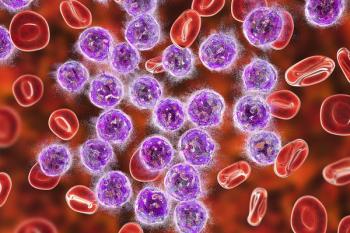
Oncology NEWS International
- Oncology NEWS International Vol 9 No 7
- Volume 9
- Issue 7
Anti-EGFr MoAb Plus RT Active in Advanced H&N Cancer
ASCO-Response rates were 100% among 15 patients with advanced head and neck malignancies treated with a combination of radiation therapy and C225 (cetuximab). Complete responses occurred in 13 of the 15 evaluable patients, James Bonner, MD, reported at the 36th Annual Meeting of the American Society of Clinical Oncology (ASCO) in New Orleans.
ASCOResponse rates were 100% among 15 patients with advanced head and neck malignancies treated with a combination of radiation therapy and C225 (cetuximab). Complete responses occurred in 13 of the 15 evaluable patients, James Bonner, MD, reported at the 36th Annual Meeting of the American Society of Clinical Oncology (ASCO) in New Orleans.
C225 is an anti-EGFr (epidermal growth factor receptor) chimeric monoclonal antibody (MoAb) being investigated by ImClone Systems Inc. The antibody was originally developed by Dr. John Mendelsohn at Memorial Sloan-Kettering Cancer Center.
While preclinical experience has shown 10 Gy radiation to have very little effect on xenografts in animals, C225 produced a marked decrement in growth. Combining radiation with C225 produced complete eradication, said Dr. Bonner, of the University of Alabama at Birmingham.
We thought this combination of treatments might be very exciting in squamous cell carcinomas originating in the head and neck, because the majority of these tumors overexpress the epidermal growth factor receptor, he stated.
Current treatment, he said, includes surgical resection with postoperative radiation, or radiation alone, which offers the advantage of sparing organ function and reserving surgery for salvage. Radiation with chemotherapy or investigational agents may also be offered.
Radiation alone is often considered the standard initial treatment. Complete response rates with radiation alone, however, are very low at 25% to 35% in unresectable and 45% to 65% in resectable tumors. In addition, locoregional control rates at 1 to 2 years are 15% to 35% for unresectable and 25% to 45% for resectable tumors, Dr. Bonner noted.
Phase Ib/IIa Trial
The University of Alabama investigators initiated a phase Ib/IIa trial of the C225/radiation combination in an effort to increase cell death by damaging tumor cells, blocking cell cycle transgression, and inhibiting tumor cells ability to facilitate DNA repair.
Patients received standard radiation therapy for 7 weeks. C225 injections were given weekly and began 1 week prior to radiation therapy, for a total of eight injections.
In this dose-escalation study, five treatment groups with three patients in each group received loading doses of C225 ranging from 100 mg/m² to 500 mg/m². Weekly maintenance doses ranged from 100 mg/m² to 250 mg/m².
Patients had histologically confirmed unresectable squamous cell carcinoma (stage III or IV), no prior radiation or chemotherapy, and no prior monoclonal antibody therapy.
Sixteen patients entered the study, and 14 were assessed for epidermal growth factor status. All of these patients expressed growth factor, and half had a rating of 3+ on a scale of 0 to 3+. Thirteen had stage IV disease, and three had stage III disease.
Thirteen of 15 evaluable patients had a complete response to therapy (87%), and 2 had a partial response, for a 100% major response rate. That was very encouraging for us, Dr. Bonner said.
He reported also that six patients failed locoregional control and subsequently died. Nine, however, are living without evidence of disease, for a 2-year actuarial survival rate of about 60%.
Adverse Events
Dr. Bonner reported that adverse events were very similar to what one might expect with an aggressive radiation-alone regimen. They included stomatitis, xerostomia, and mucositis, with one grade 4 mucositis, and one grade 4 allergic response to C225. Several patients had grade 3 mucositis.
The unique side effect of C225 is skin toxicity, a dose-dependent follicular rash over the facial and upper thoracic regions. Almost all patients (88%) developed some rash. Empiric therapy may or may not be useful for the rash, Dr. Bonner noted. The rash, he pointed out, does not interfere with the delivery of radiation to the head and neck region and resolves in about 3 to 4 weeks after cessation of treatment without scarring.
In summary, Dr. Bonner stated, this regimen produced an acceptable safety profile with non-dose-limiting toxicities consisting primarily of a follicular rash, which did not interfere with the delivery of radiation.
Durable Responses
He stated further that the mean duration of response was 16.9 months. So it is a durable responsenine patients were responding at greater than 1.5 years, and seven were in complete remission at more than 2 years.
Based on these results, the researchers felt that a phase III trial was warranted, and one is currently ongoing, Dr. Bonner said. The trial will enroll about 400 patients who will be randomized to receive standard radiation treatment alone or with weekly C225. The trial will be conducted at the University of Alabama at Birmingham as well as other cancer centers in the United States and Europe.
Articles in this issue
over 25 years ago
Couric Urges Doctors to Talk to Patients About Colon Cancerover 25 years ago
Automated Imaging Notification System Close to Fail-Safeover 25 years ago
Higher Dairy Consumption Linked to Prostate Cancer Riskover 25 years ago
First-Year Funding of Early Detection Research Network Completeover 25 years ago
Gritty Antitobacco Ads and More From Legacy Foundationover 25 years ago
Tositumomab Effective for Low-Grade Follicular Lymphomaover 25 years ago
New Awards Spotlight Courage of Cancer Survivorsover 25 years ago
Hospital Volume Shown to Predict Breast Cancer Outcomeover 25 years ago
New Drug Information Websiteover 25 years ago
NCCN Presents Updated Colorectal Cancer GuidelinesNewsletter
Stay up to date on recent advances in the multidisciplinary approach to cancer.





















































































